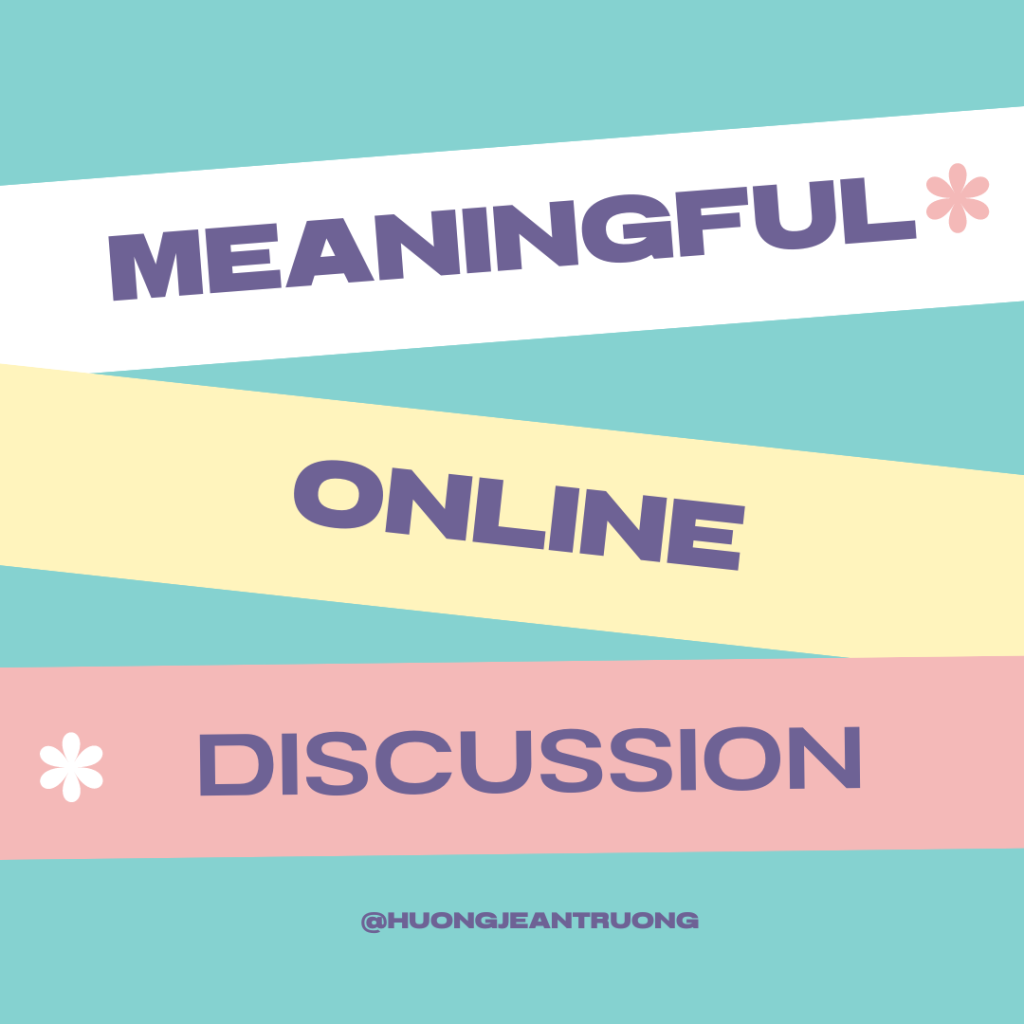what makes a meaningful online discussion?
while major considerations include group size, group composition and discussion structure (Ouyang & Scharber, 2017), instructors’ facilitation or involvement is also important to ensure the engagement and navigation of the discussion. (Shea et al., 2006)
I’m unpacking the major considerations in the below table:
Group
Size
The number of learners in a discussion group
- Learner’s interaction is higher in small group (Kim, 2013)
Group
Composition
The learners’ backgrounds in a discussion group
- Learner’s interaction is enhanced in a small heterogenous cooperative group (Fernández, 2007)
Discussion
Structure
The flow/ activities of the discussion.
- Learner’s interaction is enhanced in a distributed & opportunistic collaboration grouping (Zhang et al., 2009)
- Embrace activities as Peer moderation & role-playing. (Ng et al., 2012, Stuetzer et al., 2013)
Instructor
Facilitation
The interaction and participation with learners
- While the relationship between instructors and learner are quite complicated (Ouyang & Scharber, 2017), continuous facilitation and attention are recommended for a better outcome.
While there are no universally accepted principles for designing and facilitating discussions that effectively enhance learner interaction and participation (Brook and Oliver, 2003, Charalambos et al., 2004, Sing and Khine, 2006), I wish to share a few insights drawn from my personal experiences.
Group Size:
Determining the appropriate group size involves considering three key factors: timing availability, expected output, and total number of participants. Here’s an example to illustrate this:
- Context: I have a total of 30 minutes for a synchronous online discussion, with an expected output of three reflections from a total of 30 participants.
- Assumption: I would try to estimate the time a given individual would require to share their thoughts, let’s say, 2 minutes per reflection.
- Design: The total time needed will be (2mins) * (3 reflection) * (30 people) = 180 minutes. To fit this into the available time, we can divide the total time by the available time, resulting in 180/30 = 6 groups, which each group of 5 people. Alternatively, I could opt for groups of 10 participants, in which each member would have one minute to share their reflection.
Group Composition:
In a corporate setting, this becomes even more crucial due to the inherent hierarchical structure.
A good composition for me would include:
- One cheerleader to act as the first mover and carry the whole shy cats/first-time participants.
- One note taker.
Discussion Structure:
Providing a template for discussion or note-taking is a frequent approach of mine. Additionally, it’s vital to consider the technical capabilities of the students. For instance, are they at ease with turning on their cameras? Many online discussions become quiet because it’s unclear if a large group of learners on Zoom is comfortable using their cameras. One method I’ve found effective is asking learners to modify their display name in the format [Name-M-C] or [Name-W], where M signifies Micro, C stands for Camera, and W denotes Watching only. For example:
- Jean-M-V: She can turn on micro and and video.
- Huong-M: She can talk only.
- Truong-W: Neither microphone nor video can be used.
Instructor Facilitation:
While hosting a Zoom session, we usually have a supporting team intermittently visit different Zoom breakout rooms to ensure that both technical aspects and conversation are flowing smoothly. We also provide an alternate way for learners to reach out if they encounter any network issues.
Those are a few of my go-to practices. What are your thoughts? How do you foster meaningful and engaging discussions in your sessions?
Reference:
Ouyang, F., & Scharber, C. (2017). The influences of an experienced instructor’s discussion design and facilitation on an online learning community development: A social network analysis study. The Internet and Higher Education, 35, 34-47. https://doi.org/10.1016/j.iheduc.2017.07.002
